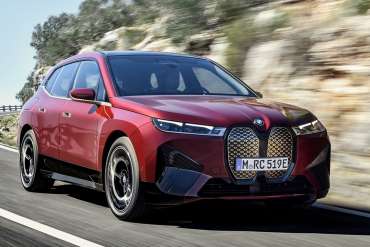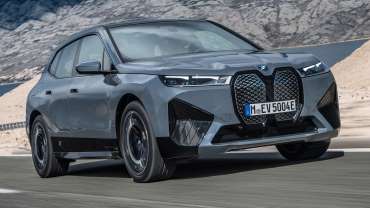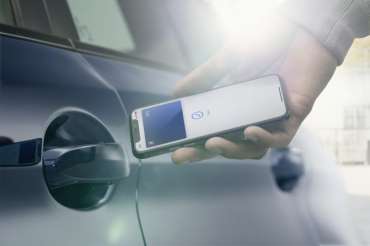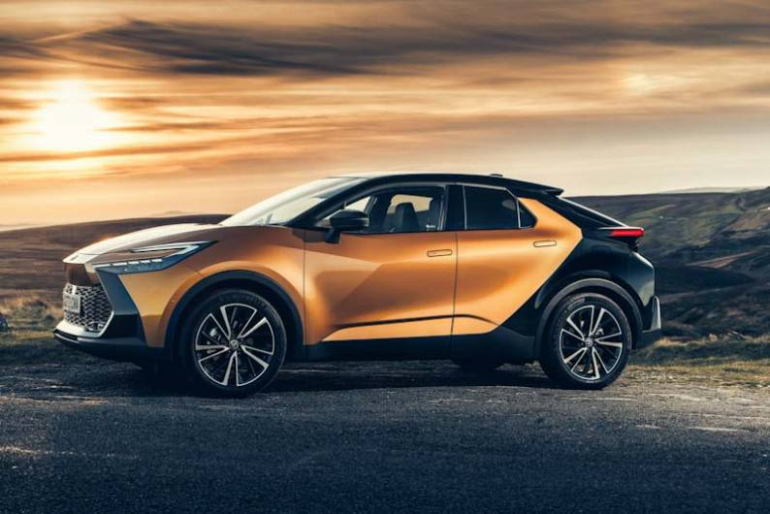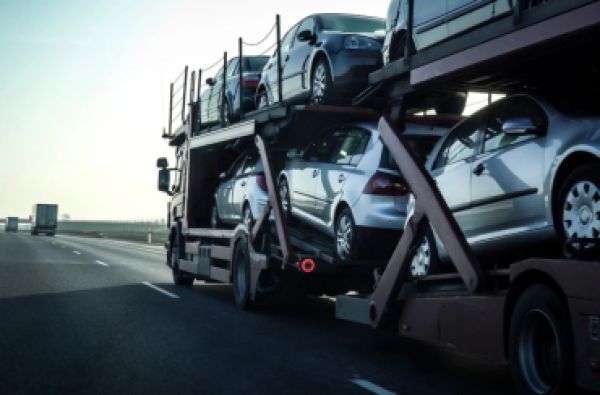Displaying items by tag: BMW iX
BMW iX review (2021)
So good you won’t care what it looks like
PROS
- State of the art purpose-built electric car from BMW
- Impressive to drive with outstanding comfort and refinement
- Eye-catching interior, packed with user-friendly technology
CONS
- Exterior design takes some getting used to
- Not all of the driver assistance tech works flawlessly
- Cheaper, more conventional BMW electric cars on the way
The BMW iX is a new purpose-built luxury electric car, and the flagship for BMW’s latest electric vehicle technology. It combines controversial exterior looks with a plush, ‘lounge-style’ interior and a seriously impressive driving experience – as well as offering a large number of modern safety and driving aids.
Rivals include the Audi E-Tron, Mercedes-Benz EQC and Tesla Model X.
Is the BMW iX any good?
If you’re in the market for a premium electric car and like to make a striking impression, BMW has definitely got you covered. Although you will also need to spend quite a lot of money. Two versions are available to buy now – iX xDrive40 and iX xDrive 50 – with an M-performance model badged xDrive M60 to follow in summer 2022.
At this stage, we’ve only driven the xDrive50 model, which commands an eye-watering £93,905 asking price in more basic Sport specification, rising to £96,905 for the fancier M Sport variant.
For that you get BMW Gen5 – fifth generation – electric motor and battery technology, and an ‘intelligent material mix’ structure that incorporates carbonfibre, aluminium and high-strength steel. For the xDrive 50, this results in the fairly spectacular combination of 523hp and 765Nm with a claimed WLTP driving range of 380 miles per charge.
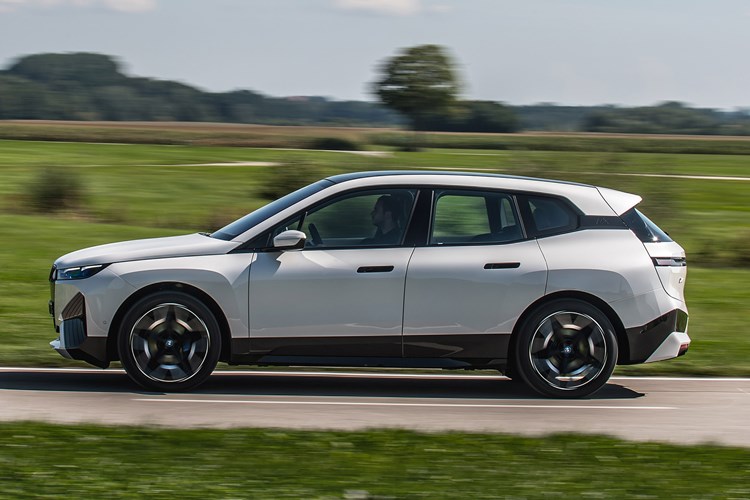
Living up to this promise, the iX is fast, comfortable, refined and outstandingly nimble for something that weighs over 2.5 tonnes and is similarly proportioned to a BMW X5 SUV. It also seems well able to deliver the on-paper driving range – though this will depend considerably on how much use you make of the available performance.
Other attention-grabbing features include a new generation of iDrive infotainment system (BMW Operating System 8) and a set of driver assistance features that include augmented-reality navigation, customisable digital and head-up displays, and adaptive brake recuperation that works superbly.
What about the way it looks?
BMW has never been a brand for building particularly beautiful cars, but there are some truly unusual angles and surfaces here. However, we would argue that it looks better in real life than it does in the pictures.
What’s more, not only is it unlikely to be mistaken for anything else – probably important for the kind of buyer who’s happy to drop nearly £100k on a BMW electric car – the design has been massaged to provide excellent aerodynamics.
This helps the iX drive faster and further, by allowing it to cut through the air more cleanly.
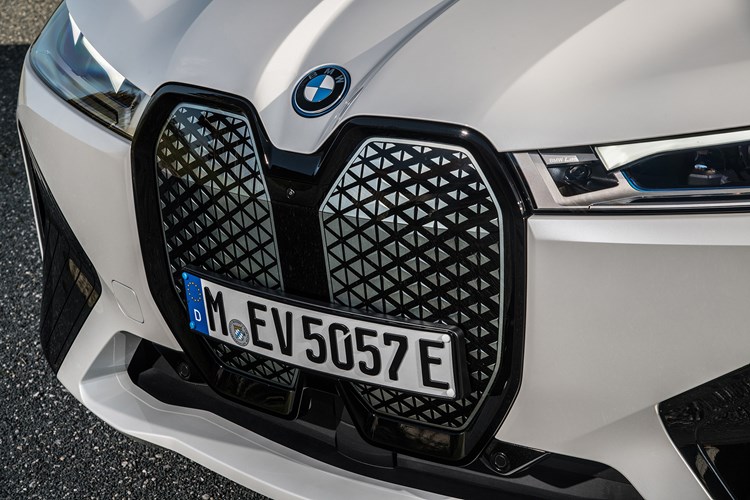
What’s it like inside?
The interior of the iX is just as unusual as the exterior – though not in such a controversial way. Here you’ll find the modern beauty of a contemporary luxury hotel room, rather than the edgy confrontation of modern art.
That’s not to say it will appeal to everyone. The slice of curving screen across the dashboard – actually two screens combined – is much as we’re coming to expect from EV interior design, while the latest iDrive software gives you comprehensive control in a reasonably instinctive manner. But the big, quilted seats are dramatic, the abrupt transition between surfaces and materials even more so, and the use of faceted crystal for some of the controls bordering on the gauche. The hexagonal steering wheel isn’t as odd to use as you might think, though.
Once again, this all helps the iX stand out against its rivals. It’s also very roomy inside, with lots of head and leg room front and rear. While there is a large battery pack under your feet, the floor doesn’t feel unnecessarily high.
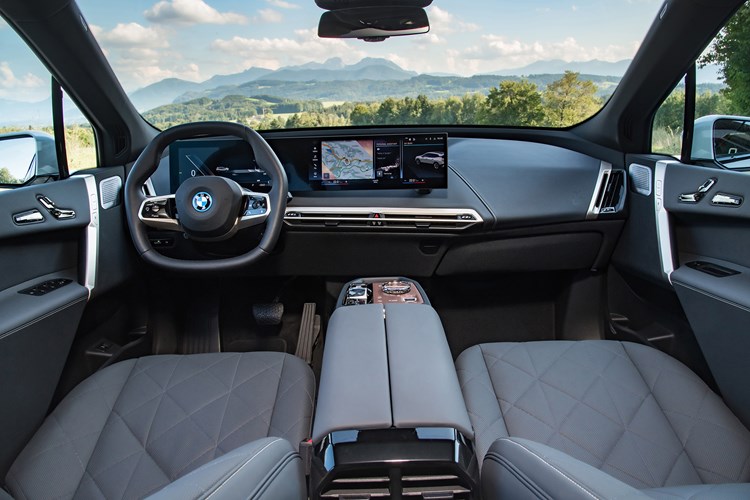
What’s it like to drive?
BMW has a reputation to uphold for exceptional driving dynamics as we move further and further into the age of electric cars, and the iX certainly isn’t going to do that reputation any damage.
Built around BMW’s first bespoke electric vehicle platform since the i3 city car, it has a very stiff bodyshell, which is then further reinforced by the large battery pack bolted to the underside. Being so stiff is a real benefit to every area of the car, as it allows the suspension to work more effectively.
The battery pack is heavy. In the xDrive50 model it contains an enormous 111.5kWh of electricity storage and weighs around 650kg. Because this weight is concentrated so low in the chassis, it not only gives the iX lots of extra strength, it also lowers the centre of gravity – which is further good news for stability when driving round corners.
Adding another touch of luxury class, the iX uses variable air suspension rather than steel springs.
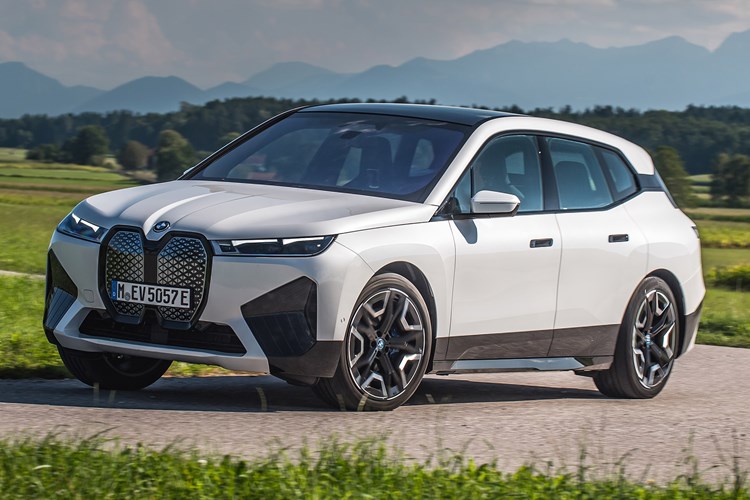
Combine all of the above, and you get a large car that manages to pull off the magic trick of riding bumpy surfaces brilliantly – despite 21-inch alloy wheels as standard – while also cornering with agility and precision on the twistiest of mountain roads. It leans a bit when really pressing on, but this only seems to highlight the depths of talent to the chassis tuning, allowing you to enjoy the process of handling it more.
Grip, meanwhile, isn’t an issue. The iX has two electric motors – one on each axle, making this the first BMW with electric all-wheel drive – and new control components mean that power can be measured out between them with exceptional speed. If one end of the car loses traction, the other compensates so swiftly the process is practically imperceptible.
Outright performance is mighty. The benchmark 0-62mph takes 4.6 seconds, but more significantly, BMW has engineered the electric motors to maintain their maximum power and torque at higher rpm. Overtaking punch is really impressive and the xDrive will hit and maintain its electronically limited 124mph top speed with ease (on derestricted autobahns in Germany).
What many owners will perhaps appreciate more, however, is the refinement. This is a very quiet car inside, even when travelling very quickly. BMW has taken the trouble to commission Oscar-winning movie composer Hans Zimmer to provide an electronic soundtrack that syncs beautifully with the way the car is being driven – but with this switched off, something that’s easily done via the infotainment system, the iX just whispers its way through the air.
What driver aids are available?
The iX is available with more driver assistance systems than BMW has ever offered before. Many of these will be familiar from other modern vehicles, but of particular interest are the elements that best show off the way the iX is properly aware of its surroundings.
For instance, it will monitor traffic lights to prompt you when they turn green. The head-up display will warn you if there are ‘dangerous’ bends ahead. The sat-nav can overlay direction information on a camera feed from the front of the car.
Our favourite example, however, is the ‘adaptive’ brake recuperation. This uses navigation and sensor data to vary the amount of braking effect you get from the motors whenever you release the accelerator – which sounds unnerving and complicated yet works remarkably intuitively. It will even allow the iX to coast at high speeds if that’s most efficient.
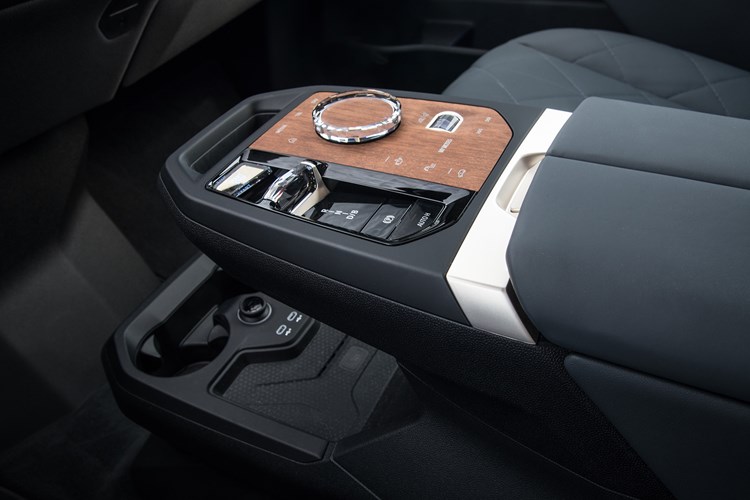
Engage the full B-mode, and you can drive almost exclusively without touching the brake pedal, as the motors will do the braking for you in all but extreme circumstances. And in exemplary fashion.
Better still, because of another integrated control unit balancing the effort between motor and traditional friction braking, when you do use the brake pedal, the feel and performance remains consistent at all times. Something that few other electric vehicles manage to pull off.
How long does it take to charge?
With 195kW fast-charging capability, the xDrive50 can be topped up with 93 miles of additional range in 10 minutes – or go from 10% to 80% in 35 minutes.
But this relies on very fast and comparatively expensive DC public chargers – the vast capacity of the battery pack means that you’ll need to allow 16 hours for 100% on a single-phase 7kW AC wallbox of the type most commonly found at UK homes and offices.
What different models and trims are available?
The iX is currently available in two versions: the xDrive40 priced from £69,905 and the xDrive50 priced from £93,905.
We’ve covered the stats of the xDrive50 in detail above. The xDrive40 produces 326hp and 630Nm of torque, does 0-62mph in 6.1sec, and has the same 124mph top speed; WLTP driving range is 257 miles.
Both versions are available in Sport and M Sport trim levels.
Standard equipment highlights for the iX Sport include an 18-speaker harmon/kardon hi-fi system, 21-inch alloy wheels, heated front seats, four-zone climate control and a substantial number of driver assistance systems.
The upgrade to iX M Sport – which costs an extra £3,000 – adds a styling package, bigger brakes, dark headlight glass and anthracite roof lining.
A car like this never has a short options list, and among the add-ons for the standard models are massaging front seats, heated steering wheel and other cabin surfaces, Bowers and Wilkins hi-fi upgrade, ‘Skylounge’ panoramic roof, Laserlight headlights, and an interior camera that can be used for security and fun.
High-performance BMW iX M60 on sale in summer 2022
In summer 2022 an M-performance model called the iX xDrive M60 joins the range. Power output for this is now confirmed at a staggering 619hp combined with a huge 1,100Nm peak torque, delivering 0-62mph in 3.8 seconds and an electronically limited 155mph top speed.
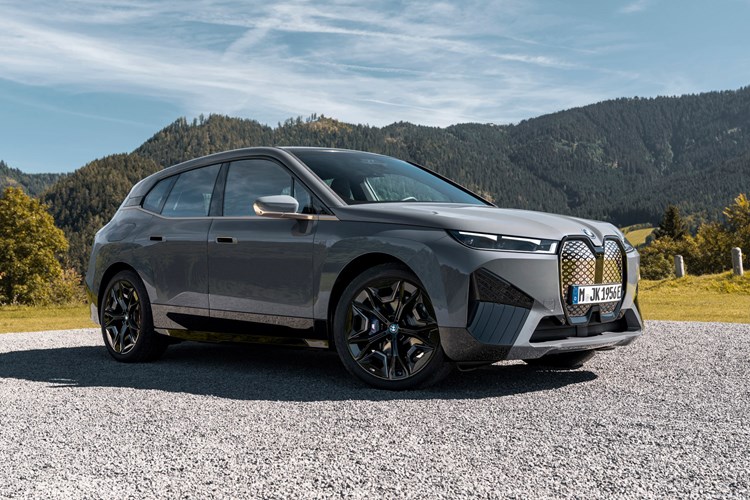
Maximum claimed WLTP driving range is equally impressive at 357 miles per charge, though it needs to impress, given pricing starts at £111,905.
For the money you also get bespoke BMW M suspension tuning, 22-inch alloy wheels, soft-close doors, powerful BMW Laserlights instead of regular LED headlights, and a technology suite that includes an interior camera, Bowers & Wilkins hi-fi, massaging front seats, heated everything, and BMW Parking Assistant Professional.
What else should I know?
The built-in connectivity means BMW will offer new features and allow customers to pay for upgrades to their iX via over-the-air updates. Among the things coming this way are an automated parking system that allows the car to learn and self-drive certain short-distance manoeuvres, which you’ll then be able to control from outside the car using your phone.
A heated element in the front grille area ensures all of the cameras and sensors built into the nose will still work when it’s snowing. BMW has put a lot of thought into this car.
BMW iX verdict
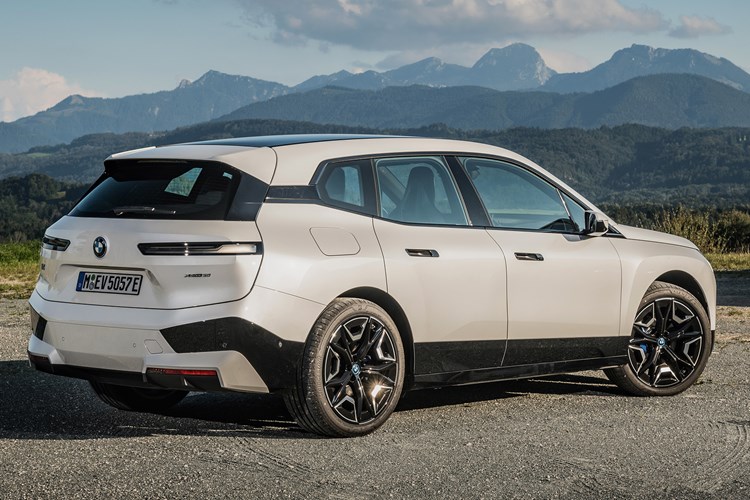
If you want a stand-out, high-price, high-quality electric car, close to the cutting edge of the current state of battery electric vehicle technology then the BMW iX could well be for you. The look of the thing is sure to raise more than a few eyebrows, but as a statement-maker that may be exactly what you’re looking for anyway.
Regardless, the interior is inviting, and the impressive blend of performance and serenity achieved by the driving experience means that even the most doubtful potential customer should at least take an iX for a test drive.
What we like
We can think of few other cars that are capable of providing such comprehensive ride comfort in combination with such cornering athleticism. The iX is at once a limousine and a creditable substitute for a sportscar – all while producing zero emissions in motion, thanks to its electric drive system.
That electric drive not only gives awesome performance, but also does things an ordinary combustion car can’t – most notably the adaptive recuperation that practically makes the brake pedal a thing of the past. Traction is mega as well, thanks to the twin-motor setup.
The technology used throughout – from the materials it’s built from to the latest iDrive – matches the iX’s price tag, while the refinement and the luxury interior put some proper icing on what is a pretty fancy automotive cake.
What we don’t like
Looks are subjective, so we’ll pass over that.
More of a concern is that not all of the driver assistance systems work consistently. With everything switched on, the iX can theoretically accelerate up to speed limits automatically as well as slow down for hazards and ‘assist’ through turns (though this relies on you touching the steering wheel – it is not a fully autonomous car). However, we found many of these facilities unreliable in action, and certainly would caution against relying on them too heavily.
Beyond this, most of the issues with the iX are the same you’ll face with any electric car – the classic being the way charging it up takes longer than filling a fuel tank. But as we all know there are means of coping with these things, and it’s getting easier and easier to live with an EV all the time.
(https://www.parkers.co.uk/bmw/ix/review/)
2022 BMW iX xDrive50 First Drive: A Glimpse at the Future
BMW’s newest SUV previews our and its electric future.
BMW is serious about going green. Forget about concept cars; starting in 2025 all BMWs will ride on what's for now called the Neue Klasse platform, a single electric vehicle architecture to rule them all. Board member and development CTO Frank Weber called the Neue Klasse "new new" and went on to describe it as "the most radical departure BMW has ever done." Until that time, the Bavarian automotive giant is launching all sorts of EVs on various other platforms, including the i4, an electric 5 Series presumably named i5, an i7, as well as a small SUV that will most likely be called the iX1. BMW already sells an electric X3 named—you guessed it—iX3, but not here in the U.S. However, the brand's most ambitious EV to date is the new iX. I just spent a day in the X5-sized electric SUV, specifically the U.S.-bound AWD 2022 iX xDrive50. How is it? Keep reading.
From a platform point of view, the iX rides on a highly modified version of BMW's CLAR platform. CLAR underpins the majority of BMW's lineup, including the 3, 4, 5, 6, 7, and 8 Series, as well as the X3, X4, X5, X6, and X7 SUVs. The Z4 and Toyota Supra, too. Perhaps a better way of explaining the iX's architecture is to say that it rides on a new high-strength steel, carbon-fiber-reinforced plastic, and aluminum spaceframe platform, but one that relies heavily on CLAR componentry. Like suspension pieces, for instance. This allows the iX to be built alongside its gasoline-powered siblings at BMW's massive Dingolfing factory. As for the competition, there hardly is any. Both archrivals Audi and Mercedes-Benz have yet to build electric midsize SUVs. Jaguar does have the slow selling I-Pace, though its short range knocks it from most people's short lists. The Cadillac Lyriq will be a worthy opponent once it shows up in a year or so. That leaves the nearly $100K Tesla Model X, which makes the $84,195 iX seem like a solid deal.
What Makes The IX?
Powering the xDrive50 are two motors, one per axle, that combined spin out 516 horsepower and 564 lb-ft of torque. Stout numbers, no doubt, though come January, the even more powerful iX M60 bows with over 600 horsepower. Those 516 ponies puts the iX just below the output the current X5 M50i gets from its twin-turbo 4.4-liter V-8, though the gas-powered X5 makes slightly less torque (553 lb-ft). BMW wants to show consumers there's no performance hit for choosing an EV, at least on paper. We haven't tested or weighed the iX yet, though the EV is much heavier. BMW is quoting an EU-specified curb weight of nearly 5,700 pounds.

That Face
How about that grille? That's the new face of BMW. Hate it? Well, every human on Instagram seems to agree with you. That said—and yes, I'm obviously old, soft, blind, and on BMW's payroll—in person I thought the iX's face looked, dare I say it, good? There was something about the massive kidney grilles and the narrow, robot-like eyes that just worked. Almost like a second-generation Cylon from the Battlestar Galactica reboot. It's miles better than the grille on the new M3/M4, at any rate. Back to Instagram, the big question seemed to be, if there's no engine, why is there a grille at all? Aside from branding, the twin grilles (which are covered in self-healing skin) are cleverly stuffed with sensors, including two types of radar. As for the rest of the exterior, the hard side is nearly generic save for the floating roof. From the rear, the taillights look too skinny, and the body-colored bumper makes the iX's butt look fat.
Inside The IX
The iX's interior is an exercise in minimalism, at least for BMW. A massive, curved touchscreen dominates the cabin. In days past, BMW has angled the controls toward the driver. In an homage to days of yore, the screen (that contains the controls) bends toward the driver. The number of buttons has been reduced by 50 percent, what BMW considers the bare minimum. That said, if you look down at the lovely piece of wood that surrounds the iDrive knob, you'll see 12 buttons, not counting the controller itself (which does click down and in the X and Y axis) but including the volume wheel. The buttons that remain are logical, and there's a calmness and spaciousness to the interior that's new for the brand. However, there's also a sparseness that just doesn't scream premium luxury to me. And at nearly $85K to start, it ought to.
Technically speaking, the iX is stacked. The latest and eighth iteration of iDrive is more powerful than ever. I know this because I sat through at least three iDrive workshops while I was in Munich. Three! Just know that if you say, "Hey BMW, take a selfie," the iX takes a picture of you. No, really. However, the selfie camera is there as a security feature. Did you leave your wallet or purse on the front seat? Just open your phone and have a look. Speaking of wild tech, meet Maneuver Assistant. Long story short, Maneuver Assistant records how you park the iX—say, in a tricky spot in your garage—like a macro. The iX will then repeat the maneuver whenever you tell it to. Said maneuver can be up to 200 meters long. The iX can store up to 10 such maneuvers. Here's the coolest part: The maneuvers can then be transferred from profile to profile. Meaning you could record the move and then transfer it to your spouse/your kid's profile. That's dang nifty, no?

But How's It Drive?
First impression: Driving around Bavaria's gorgeous Berchtesgaden region that puts the verdant in verde, one is reminded why going green is so monumentally important. I want your kids to see what I just saw. Ahem. Pointed down the mountain with the iX xDrive50 in efficient mode, simply lifting off the throttle allows the iX to coast. The sensation is wonderful, as if the machine is suddenly free. I guess there's enough brake regen to hold the speed, but it feels like you're sailing. I know some EV enthusiasts (they exist, trust me) love huge levels of regen and one-pedal driving and all that, but I prefer to freefall. The iX is remarkably quiet, bordering on perhaps a bit too quiet. The BMW Group's other spaceframe products, Rolls-Royces, are in fact too quiet. What does too quiet mean? You can hear your own heart beating. The iX comes close.
One area where the bmw ix struggles is that it doesn't sound or feel particularly premium. I know I'm sitting on leather, but the interior has been simplified so much that I feel like I'm in a device, as opposed to a luxury vehicle. I would love to see the (eventual, I hope) Alpina version of the iX, one that's generously slathered in leather. The xDrive50 is slick and high-tech, but there's a Tesla-like sparseness that doesn't connect with me. Plus, the spot that's normally a drivetrain tunnel is simply empty space. Like in a cargo van. Now, maybe that was the design team's intention? Maybe they said, "Look, Tesla is dominating the EV space, and we need to be more like it." If that's the case, then BMW really has succeeded in going minimum. Some customers might even dig it. Call it the Tesla Syndrome. But for my large hunk of cash, I'd like some more wood, metal, and leather. To me, the Tesla aesthetic doesn't work here.
As for driving on curvy, fun Bavarian roads, it's fine. The iX drives at least as well as the Tesla Model X, and now that I'm thinking about it, quite similarly. That impression makes sense as both weigh about the same, have said weight located in the same spots, and make about the same power. To be clear, I'm talking about the last Model X I drove back in 2016 when the 90D version of the electric three-row SUV produced 518 horsepower from its two motors. For 2022 you now choose between 670 Long Range or 1,020 ponies in the Plaid. Like the equally heavy Tesla, the iX is betrayed by physics. This might be part of why this EV SUV doesn't necessarily feel premium. There's a minivan quality that's hard to get past. I'm not feeling the ultimate driving machine. I'm not feeling BMW as a brand in the way it tackles a road. It's quite like how I felt about the i3. Interesting car, interesting concept, but doesn't feel the way a BMW should feel when I close my eyes. The iX just feels like… an electric thing. That said, the noise the motors make (or is that coming from the speakers?) is quite cool.
Let's Talk Range
As far as range goes, I left the hotel at 96 percent charge, and 20 kilometers later the battery was still at 96 percent. I had been in Eco Pro mode most of the time and was pointing downhill. But still, that's impressive. Six km later, the battery was still reading 96 percent. Wanting to burn a little juice, I switched out of the efficient mode and into Comfort. In 4 km, it was still showing 96 percent. I was starting to think the computer was broken. Also, the range was telling me I didn't have to charge for 565 km (351 miles) and that I would arrive at my first destination in 28 km with 89 percent of the battery left. When I started, the computer said I'd make it with 88 percent remaining. The computer therefore doesn't account for downhill driving or elevation changes in the range estimates, so keep that in mind as I'm sure the opposite would be true going uphill. I made it to the first stop having consumed just 1 percent of the battery's juice. Not bad. As mentioned, the iX will probably be rated right around 300 miles of range in the U.S. Based on my driving experience, I predict BMW is going to have a Porsche Taycan situation on its hands, where the EPA rated the Turbo S version at 192 miles of range, but it's actually capable of over 250.

After my first stop, it was time for some freeway. Let me be the first to say that the bmw ix whips ass on the autobahn. This is a seriously quick EV, especially accelerating from about 75 mph to 105 mph. Let me be the billionth person to say, God bless unrestricted sections of autobahn. I took the iX up to its top speed of 124 mph (200 kph) just to check things out, and you can feel the computer shutting down the fun right when you nudge past 120 mph. However, I set the cruise at 170 kph (about 106 mph) and had a couple of realizations. The first is that moving this quickly in absolute silence (I had it in Eco Pro mode) is quite cool. There's hardly any wind noise—it's like being in a private jet. Second, the iX is aerodynamic enough (0.25 claimed Cd) that even well into the triple digits the range isn't affected too negatively. I travelled 30 km (about 19 miles) at 170 kph and used only 4 percent of the battery. Moreover, the adaptive cruise control and lane keeping assist work as well as anything, save for Cadillac's impossibly good Supercruise. Once you're moving in a high-speed, straight line, the iX drives great.
Conclusion
The 2022 bmw ix previews many things coming down the automotive pike. Not only is it a glimpse into BMW's sustainable, electric, carbon-neutral future, but this type of machine—an electric carlike SUV-sized people mover—will become the dominant mode of first-world personal transportation within the decade. As a signpost pointing toward the future, I feel confident concluding that we're in good shape vis-à-vis the driving world to come. But as a BMW? I'm struggling here. For whatever reason, I want and expect all BMWs to drive better than other machines, or at least most other machines. This is probably an unreasonable expectation, but dammit, all BMWs used to have an X factor. I can still remember driving an ex's E39 540i two decades ago. The relationship went nowhere, but I got a memory that will last a lifetime. As for the all-new bmw ix when it arrives in Q1 of 2022, we Americans will have a fast, powerful, efficient, tech-laden yet minimalist SUV in a segment with few serious competitors. I just wish the iX were a bit more memorable.
(https://www.motortrend.com/reviews/2022-bmw-ix-xdrive50-first-drive-review/)
Smartphones will soon replace car keys
Although it is not news that the car is unlocked with a mobile phone, although only from close range, there is now a new technology on Wednesday that will allow us to do it remotely, as we normally do with keys.
Among the many things that smartphones have "suffocated" or at least pushed into the background, such as MP3 players, digital cameras, GPS devices and bank cards, we will soon add another to this list that we use every day - car keys .
Although mobile phone unlock technology is already in use, it is NFC-based, which means you have to lean the phone against the vehicle, but thanks to another technology (UWB), cars will unlock phones remotely, as they do now we work with keys.
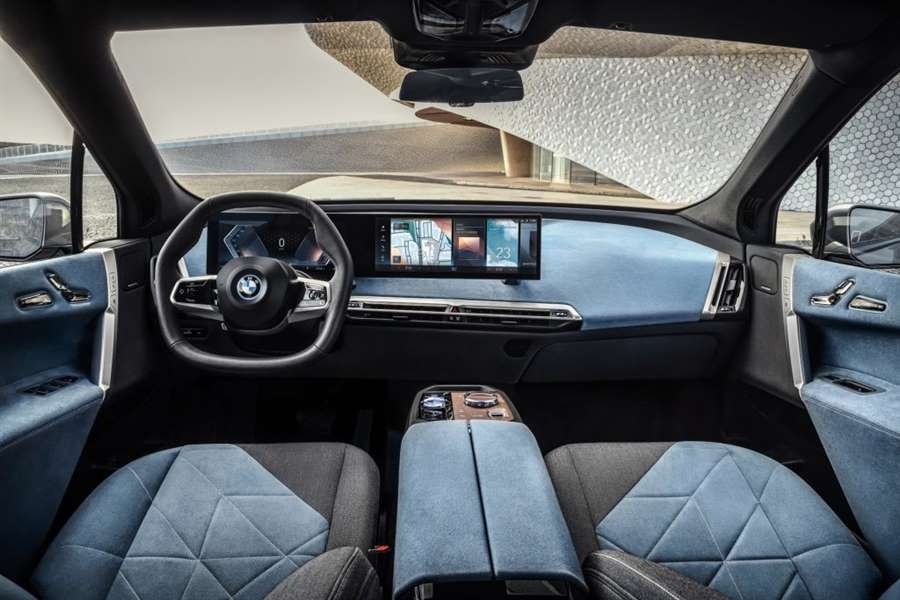
BMW iX, Photo: Promo
New models of Apple phones come with this technology, so BMW recently announced that UWB will use it on its new iX series electric vehicles.
The principle on which UWB works is best described on Wired, calling it "bluetooth on steroids", while Apple calls it internal GPS.
It is a short-range radio technology that will enable not only wireless communication with other devices, for example. unlocking the car door remotely, but also finding other devices nearby, similar to how devices like Tile's popular locators do.
Apple is not the only mobile company whose phones have UWB support - Samsung recently announced the Galaxy S21 series, which also implements this technology, and even before that, Xiaomi in the Mi10 series.
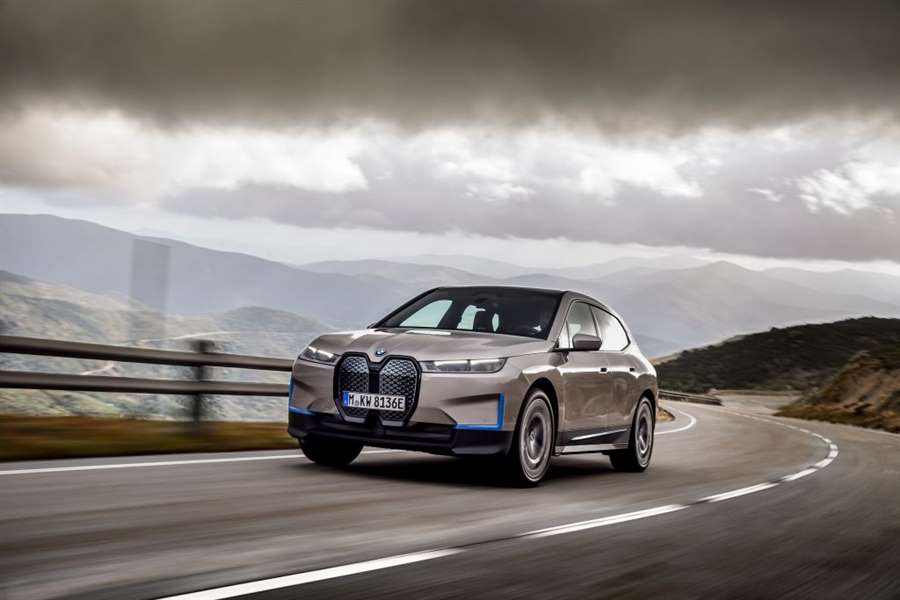
BMW iX, Photo: Promo
It seems like this is just the beginning because, according to information from the mobile industry, more and more companies are planning to introduce a phone with UWB support. So this year we can expect new Xiaomi phones with UWB support, but such devices are also being prepared by Oppo, Vivo and other companies, which means that many phones of the future will be able to replace car keys.
Of course, in addition to mobile manufacturers, UWB should also be accepted by car manufacturers. BMW has already confirmed this, and Samsung has announced that it is also cooperating with Audi, Ford and Genesis, so it is not difficult to assume that in the (near or distant) future, support for digital keys could become an industry standard.

